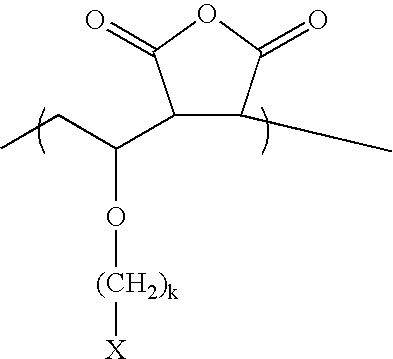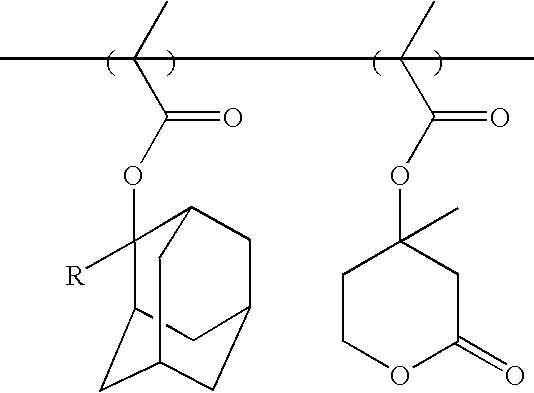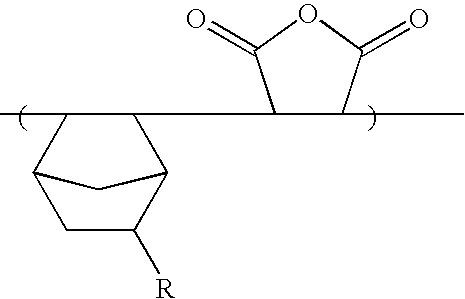Photosensitive polymers, resist compositions comprising the same, and methods for forming photoresistive patterns
a technology of resist materials and compositions, applied in the field of photosensitive polymers, can solve the problems of resist materials suitable for use with arf eximer lasers suffering from a variety of drawbacks, increasing density and complexity of semiconductor devices, and increasing complexity, etc., to achieve the effect of reducing the temperature of glass transition, facilitating the use of anneal processes, and increasing film hardness
- Summary
- Abstract
- Description
- Claims
- Application Information
AI Technical Summary
Benefits of technology
Problems solved by technology
Method used
Image
Examples
synthesis example 1
Synthesis of 2-Hydroxy-2-adamantylethyl Vinyl Ether (I)
(Step-1) Mercury acetate (5 mol %) was added to a round bottom flask containing 3-chloropropanol (48 g, 0.5 mol) and ethyl vinyl ether (180 g, 2.5 mol). Next, the resulting mixture was refluxed for 8 hours. After the reaction was completed, 3-chloropropyl vinyl ether was obtained through vacuum distillation of the reaction solution.
(Step-2) Magnesium metal(2.6 g) and anhydrous tetrahydrofuran (hereinafter referred to as THF(100 mL)) were added to a round bottom flask. Next, after dripping a small quantity of dibromoethane into the round bottom flask containing the resulting mixture to promote the reaction, 3-chloropropyl vinyl ether (12 g, 0.1 mol) and anhydrous THF(100 mL) were added drop-wise thereto. Then, the mixture was reacted for 2 hours. After dripping an adequate quantity of THF containing 2-adamantanone (15 g, 0.1 mol) in the mixture, the resulting mixture was refluxed for 12 hours. After the reaction was completed, th...
synthesis example 2
Synthesis of 8-Hydroxy-8-tricyclodecylethyl Vinyl Ether (II)
The monomer having the form of a tertiary alcohol can be easily synthesized by using 8-tricyclodecanone (0.1 mol) through Grignard reaction by the same method as that of Synthesis Example 1. (Yield: 60%)
Meanwhile, various monomers having the form of a tertiary alcohol can be synthesized using the same method as in Synthesis Example 1 by reacting cyclic ketone or alicyclic ketone compounds with various Grignard reagents of haloalkyl vinyl ether. The cyclic ketone or alicyclic ketone includes cyclopentanone, cyclohexanone, 2-norbornanone, 2-adamantanone, 8-tricyclodecanone, etc. It is preferable to use haloalkyl vinyl ether having a methylene linkage having 3 to 6 carbon atoms.
synthesis example 3
Synthesis of Copolymer
The monomer (11 g, 50 mmol) prepared by Synthesis Example 1 and maleic anhydride (5.0 g, 50 mmol) were dissolved in THF (40 g), and azobisisobutyronitrile (hereinafter referred to AIBN (2 mol %)) was added thereto. After purging it with nitrogen gas, the mixture solution was polymerized at a temperature of 70° C. for about 12 hours. After polymerization, the reaction product was precipitated slowly in excessive n-hexane and the precipitates were filtered. Next, after dissolving the resulting filtrate in THF and re-precipitating it in n-hexane, the precipitated solution was dried in a vacuum oven maintained at 50° C. for about 24 hours to obtain a copolymer product. (Yield: 85%) (Mw=9,700) (Mw / Mn=2.0)
PUM
| Property | Measurement | Unit |
|---|---|---|
| Temperature | aaaaa | aaaaa |
| Temperature | aaaaa | aaaaa |
| Percent by mass | aaaaa | aaaaa |
Abstract
Description
Claims
Application Information
 Login to View More
Login to View More - R&D
- Intellectual Property
- Life Sciences
- Materials
- Tech Scout
- Unparalleled Data Quality
- Higher Quality Content
- 60% Fewer Hallucinations
Browse by: Latest US Patents, China's latest patents, Technical Efficacy Thesaurus, Application Domain, Technology Topic, Popular Technical Reports.
© 2025 PatSnap. All rights reserved.Legal|Privacy policy|Modern Slavery Act Transparency Statement|Sitemap|About US| Contact US: help@patsnap.com



